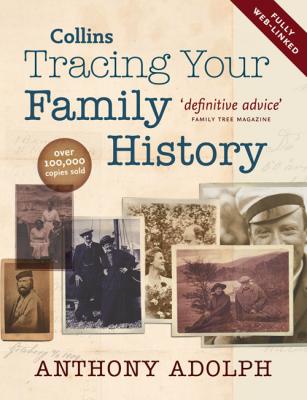Collins Tracing Your Family History. Anthony Adolph
Читать онлайн.| Название | Collins Tracing Your Family History |
|---|---|
| Автор произведения | Anthony Adolph |
| Жанр | Справочная литература: прочее |
| Серия | |
| Издательство | Справочная литература: прочее |
| Год выпуска | 0 |
| isbn | 9780007373567 |
INDIA OFFICE LIBRARY
NATIONAL ARCHIVES OF INDIA
nationalarchives.nic.in/
PAKISTAN NATIONAL ARCHIVES
DIRECTORATE OF ARCHIVES AND LIBRARIES
KENYA NATIONAL ARCHIVES
REGISTRAR GENERAL’S DEPARTMENT
PROFESSIONAL GENEALOGISTS AND RECORD AGENTS
An increasing number of people and small firms are advertising their services as researchers in genealogical magazines such as Family History Monthly, in the Genealogical Services Directory and similar publications, and in the lists of independent searchers maintained by many record offices. They come in two categories – professional genealogists like me who plan, implement, direct and report on projects investigating family trees; or record agents, who are hired to undertake very specific pieces of research at their client’s instructions. It is best to hire those who are qualified under educational systems such as the IHGS or who have a proven track record of experience and professionalism. Many belong to organisations such as the Association of Genealogists and Researchers in Archives (AGRA), but be aware that membership often means just that and does not imply very stringent tests of ability.
There are very few dishonest researchers in the field, but a great many incompetent ones. If someone’s initial response to your enquiry is in any manner unprofessional (badly typed or not typed at all), throw it away. Very few professionals worth their salt are without email. Whoever you hire, make sure that they understand exactly what you want to know before you part with your money.
Be equally understanding, though, that professionals must charge for their time and effort regardless of whether they find exactly what they and you were hoping for. Negative results must be paid for too and it is not always entirely negative to know where an ancestor was not.
QUICK REFERENCE
INSTITUTE OF HERALDIC AND GENEALOGICAL STUDIES (IHGS)
www.ihgs.ac.uk
ASSOCIATION OF GENEALOGISTS AND RESEARCHERS IN ARCHIVES (AGRA)
www.agra.org.uk
GENEALOGY SURVIVAL KIT/1
THESE PAGES contains various miscellaneous but also very useful facts to help you in your research.
ENGLISH WORDS
OLD HANDWRITING
Reading old handwriting is called palaeography. There are two sorts of problems:
1. In the past, some letters were written differently to the way they are now, so are extremely unfamiliar.
Examples of the different styles of letters are given to the below.
2. Bad handwriting. However, like cracking codes, you can often work out what an incomprehensible letter is by studying its companions. For example, if you can read ‘Ed-ard’ then you can surmise the other letter is a ‘w’ – but look for the letter elsewhere to make sure you have it right: never go with an unsupported guess.
MONEY
DATES
OLD STYLE AND NEW STYLE
